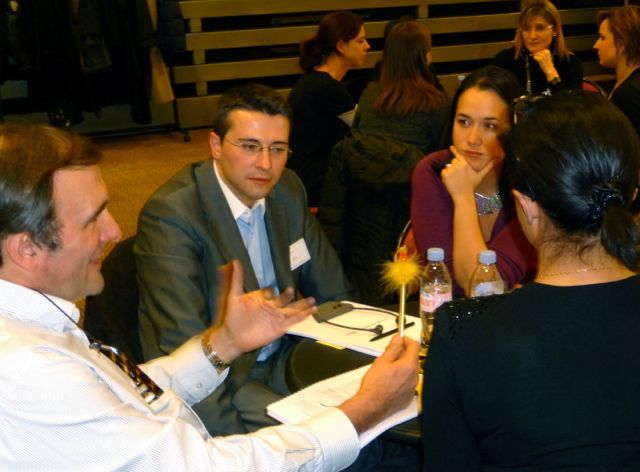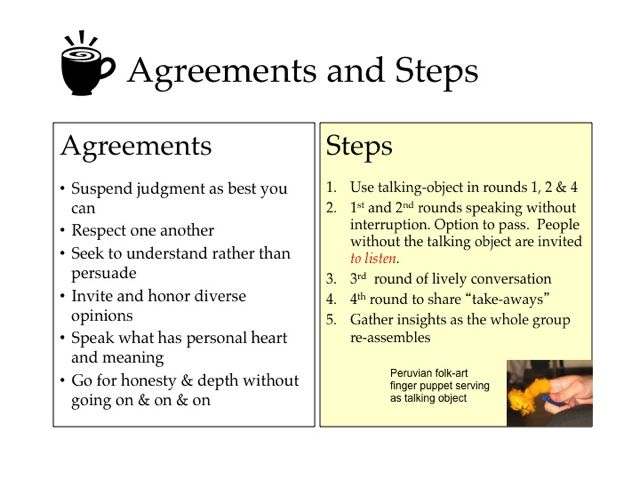![]() Conversation Café
Conversation Café
Engage Everyone in Making Sense of Profound Challenges (35-60 min.)
What is made possible? You can include and engage any number of people in making sense of confusing or shocking events and laying the ground for new strategies to emerge. The format of the Conversation Café helps people have calm and profound conversations in which there is less debating and arguing, and more listening. Sitting in a circle with a simple set of agreements and a talking object, small groups will engage in rounds of dialogue with little or no unproductive conflict. As the meaning of their challenge pops into focus, a consensual hunch is formed that will release their capacity for new action.
Five Structural Elements – Min Specs
1. Structuring Invitation
- Invite all the participants to gather in small groups to listen to one another's thoughts and reflect together on a shared challenge
2. How Space Is Arranged and Materials Needed
- Unlimited number of 5 to 7 chairs around small tables
- Talking object (e.g., talking stick, stone, or art object)
- Markers and one or two pieces of flip-chart paper per table optional
3. How Participation Is Distributed
- Everyone is included
- Everyone has an equal opportunity to contribute
4. How Groups Are Configured
- Mixed, diverse groups of 5–7 participants
5. Sequence of Steps and Time Allocation
- State the theme of the conversation, usually in the form of a question
- Explain there will be four rounds of conversation at every table, two first rounds using a talking object, the third one as open conversation, and a final round with the talking object. Give the duration of each round.
- Distribute the talking objects
- Read the six Conversation Café agreements. See text in Collateral Material below.
- Ask for someone at each table to volunteer as the host. The host is a full participant whose role is to gently intervene only when a participant visibly fails to observe one of the six agreements, most frequently talking on and on
- First round with the talking object: each person shares what he or she is thinking, feeling, or doing about the theme or topic. 1 min. per person
- Second round with the talking object: each person shares thoughts and feelings after having listened to everybody at the table. 1 min. per person
- Third round: open conversation (option to use talking object). 20–40 min.
- Fourth round with the talking object: each member shares “takeaways.” 5–10 min.
WHY? Purposes
- Make sense of a complex, difficult, or painful situation and lay the ground for being able to move on
- Generate new ideas and momentum for innovation
- Build shared understanding of how people develop different perspectives and ideas
- Avoid arguments based on lack of understanding
- Build trust and reduce fear with an opportunity for catharsis
- Help participants appreciate that conversation involves talking and listening
Tips and Traps
- Always use the talking object: they make the difference
- Have the host or participants reread the six agreements before starting the first round
- Do not assign tasks: there should be no intention that the dialogue will directly lead to action
- Host the dialogue like a dinner party, encouraging everyone to contribute while keeping the conversation open-ended and spontaneous
- Use Wicked Questions to deepen conversation
- If there is a problem, ask, “Are we following our agreements?”
- Encourage people to speak their mind
- Encourage quiet people to talk
- Select talking objects that may have symbolic meaning for participants
- Encourage participants to draw or record insights on the flip-chart “tablecloth”
- Learn more from Vicki Robin and friends, who created the Conversation Café for use in communities @ www.conversationcafe.org
Riffs and Variations
- All participants but one at each table can move to different tables every 20 minutes World-Café style (see www.worldcafe.com for more information).
- Link to Graphic Recording. Place flip-chart paper on each table to collect insights from each group. Encourage drawing and playful exploration.
- To move into action, string together with W3 (What, So What, Now What?), 15% Solutions, Design StoryBoards, User Experience Fishbowl, or Open Space.

A playful talking object invites deeper listening in Paris
Examples
- For making sense of and start recovering from a major setback or shock in the market or operating environment (e.g., first used in US communities after 9/11)
- For exploring a new topic or trend that is not well understood
- For handling a topic where there will be strong feelings expressed
- For reflecting after a major change: What does it mean? What assumptions can we make? What conclusions make sense? What can we now believe?
Attribution: Liberating Structure developed by Henri Lipmanowicz and Keith McCandless. Inspired by and adapted from Vicki Robin and Susan Partnow, codevelopers of Conversation Cafés.
Collateral Material
Below: Presentation materials we use to introduce Conversation Café

